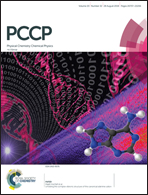Effect of magnetic fields on the methyl rotation in a paramagnetic cobalt(ii) complex. Quasielastic neutron scattering studies†
Abstract
Molecular dynamics is a fundamental property of metal complexes. These dynamic processes, especially for paramagnetic complexes under external magnetic fields, are in general not well understood. Quasielastic neutron scattering (QENS) in 0–4 T magnetic fields has been used to study the dynamics of Co(acac)2(D2O)2 (1-d4, acac = acetylacetonate). At 80–100 K, rotation of the methyl groups on the acac ligands is the dominant dynamical process. This rotation is slowed down by the magnetic field increase. Rotation times at 80 K are 5.6(3) × 10−10 s at 0 T and 2.04(10) × 10−9 s at 4 T. The QENS studies suggest that methyl groups in these paramagnetic Co(II) molecules do not behave as isolated units, which is consistent with results from earlier magnetic susceptibility studies indicating the presence of intermolecular interactions. DFT calculations show that unpaired electron spin density in 1 is dispersed to the atoms of both acac and H2O ligands. Methyl torsions in 1-d4 have also been observed at 5–100 K in inelastic neutron spectroscopy (INS). The QENS and INS results here help understand the dynamics of the compound in the solid state.



 Please wait while we load your content...
Please wait while we load your content...